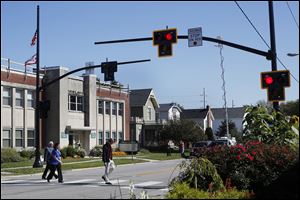
$75,000 SYSTEM LESS COSTLY THAN TYPICAL
Delta’s new crosswalk signal a unique design for the region
10/9/2013
Ohio Department of Transportation and the village of Delta installed a new traffic safety device.
THE BLADE/KATIE RAUSCH
Buy This Image

Ohio Department of Transportation and the village of Delta installed a new traffic safety device.
DELTA, Ohio — According to state standards, Delta didn’t really need the traffic lights that once governed three Main Street intersections just west of the village hall anymore.
But what local officials said this Fulton County village still needed was the crosswalk on Main, which is part of State Rts. 2 and 109 and heavily used by truck traffic for two steel plants just west of Delta.
Without the three stoplights, the only protected crosswalk was several blocks farther east, at Madison Street.
The solution was a new kind of crosswalk signal — one never before installed along a state highway in Ohio, to govern vehicle traffic.
Like a typical stoplight, it has three lamps, but that’s about where the similarities end.
During a ceremony Wednesday, Pike-Delta-York first grader Johnathan Brasher strode purposefully across Main after becoming the first to push the button, an honor for which he was chosen by a random drawing.
“That was pretty cool, how I’m the first,” Johnathan said after crossing back to the north side of the street while several dozen of his schoolmates took their first walks across the street after triggering the crosswalk light a second time.
“I think it’s going to be very beneficial to the kids, to keep them safe going to and from school,” said Ellen Bernal, the local grade school’s principal.
Police Chief Nathan Hartsock called the new signal “a great addition to the village,” and said that for the first 30 days, officers will issue warnings, not tickets, to motorists who don’t observe it quite right — “unless there is an accident.”
The crosswalk signal has standard Walk/Don’t-walk icons to govern pedestrians, but for motorists its signals have two red lamps with a yellow lamp beneath them.
Normally, all lamps are dark, but when a pedestrian pushes a button, the yellow lamp lights up — first flashing, then steady. After about six seconds, the two red lights illuminate and the crosswalk signal changes from Don’t Walk to Walk.

After about 7½ seconds, the Don’t Walk signal starts flashing, instructing anyone not already using the crosswalk not to start across. The two red lights for traffic also start flashing at that time, telling motorists that once pedestrians have cleared the crosswalk, they may proceed.
The flashing Don’t Walk has a 14-second countdown clock, after which it changes to steady and the red lights for traffic go dark again.
Jason Atkins, an ODOT traffic engineer, said the system cost about $75,000 to install, which is $50,000 less than a standard traffic light.
Mr. Atkins said he was unaware of any other such signals in Ohio, and this was definitely the first use on a state highway. The pioneer, he said, has been Tucson, which has 92 of them.
Until 2009, Delta had traffic lights on Main at Wood, Lincoln, and Monroe streets. But that year, the stoplights’ control system wore out, and with no money to replace it, the lights were placed on flashing yellow for Main and flashing red for the side streets.
ODOT provided funds to replace a nearby signal at Main and Madison, where Route 109 from the south joins Route 2 to go through town. But the state wouldn’t help with replacing the other three, which it deemed unnecessary based on traffic counts.
Patricia Grover, director of the Delta Public Library, questioned whether 22 seconds was enough time for slower-moving people to cross — people like Tony Dawson, a Delta resident who uses a walker and needed every bit of that time to get across Main after he pushed the button.
Mr. Atkins said the timing was based on a walking speed of 3½ feet per second.
“We can revise that at individual locations, especially if we have a request,” the ODOT engineer said.
Contact David Patch at: dpatch@theblade.com or 419-724-6094.